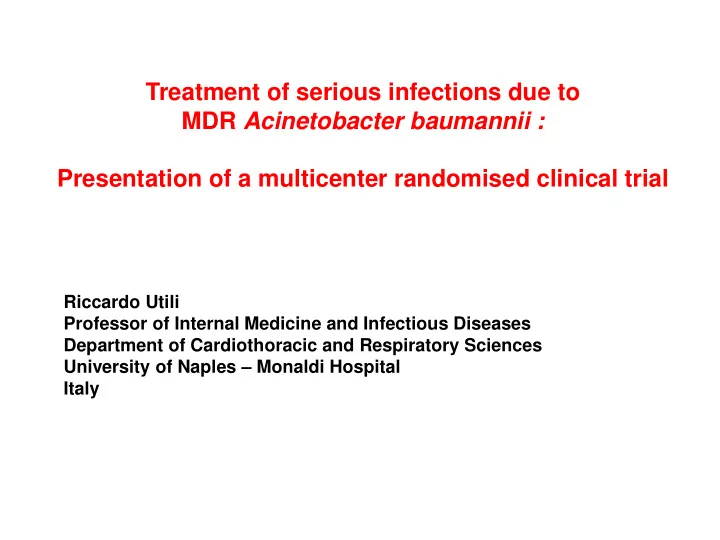

Treatment of serious infections due to MDR Acinetobacter baumannii : Presentation of a multicenter randomised clinical trial Riccardo Utili Professor of Internal Medicine and Infectious Diseases Department of Cardiothoracic and Respiratory Sciences University of Naples – Monaldi Hospital Italy
R. Utili - Disclosures Speaker activity for Novartis, MSD, Pfizer Research support: Novartis, MSD, Pfizer
Difficulties in planning therapeutic trials for A. baumannii infections A. baumannii infections (especially VAP) usually occurs late in the course of a severe disease (multiple comorbidities) in the ICUs Thus, patients may die for the Acinetobacter or with the Acinetobacter. Crude mortality rate is high (40-60%) Attributable mortality is a clinical judgment (risk of assessment bias) it can only be estimated in a case control study Need of strong outcomes to get reliable results , i.e., - 30 day mortality (including later f-u or out of hospital events) - microbiological data collected at predetermined times - lenght of hospitalisation
A. baumannii: a ‘successful pathogen’ Imipenem - Meropenem Cefalosp 1-2-3 gen (not Aztreonam) Ampicillin PBP2 Loss of OMP (outer alteration membrane proteins) – USA & Europe (Oxa; Imp; VIM) Plasmides - Europe Porins AmpC B- Integrons for lactamase VIM-IMP-OXA-ESBL-MEX-OPR MDR (hyperproduction in 50% of isolates) Aminoglycoside modifying enzymes Efflux Pumps MexAB-OprM (AMEs) aztreonam Fq, B-lactams, CAF, aminoglycosides macrolides, sulfamides trimetoprim, tetraciclines Adapted from Limanski JCM 2002; Urban CID 2003
Only option available COLISTIN It acts by altering membrane permeability Poor lung diffusion Nephrotoxic Overall low efficacy when used as monotherapy Treatment is largely empiric
Antibiotic combinations as an alternative approach to colistin monotherapy 10 9 8 Log10 (viable cells) CFU/mL 7 CT 6 RIF 5 4 COL 3 COL + RIF 2 1 0 0 4 Time (h) Tripodi MF, Utili R et al. Int J Antimicrob Ag 2007
Co.R.A.b. study Colistin vs Colistin+Rifampicin in A.baumannii infections Open label, parallel, randomized 5 clinical sites, 210 pts enrolled (2008-2011) (Funded by the Italian Medicines Agency, AIFA; ClinicalTrials.gov number, NCT01577862). Utili R., Durante-Mangoni E., et al. under evaluation
Co.R.A.b. study Colisitin vs Colistin+Rifampicin in A.baumannii infections INCLUSION EXCLUSION CRITERIA CRITERIA • Previous treatment with • Age >18 y colistin or rifampicin • ICU admission • Hypersensitivity to either • Life-threatening infection study drug (HAP, VAP, BSI, cIAI) • Significant liver dysfunction • Positive A.baumannii cultures (serum conjugated bilirubin >3 • XDR antibiotype mg/dl). • Strain susceptible to colistin Utili R., Durante-Mangoni E., et al. under evaluation
Typical antibiogram
Co.R.A.b. study Treatment arms Colistin monotherapy Colistin + Rifampicin combination • Colistimethate sodium • Colistimethate sodium, same dose • 2 MU (=160 mg), q8h, i.v. • Rifampicin, 600 mg q12h, i.v. • Treatment duration: 10-21 d. • Treatment duration: 10-26 d. Randomization • Centre site • Simplified Acute Physiology Score (SAPS) II <40 or ≥40 Utili R., Durante-Mangoni E., et al. under evaluation
COLISTIN AND RIFAMPICIN FOR XDR-ACINETOBACTER 0 4 7 11 14 21 COLISTIN, 2MU TID 10-21 days EoS t0 EoT CENTRAL RANDOMIZATION Acinetobacter baumannii • CENTRE infection • SEVERITY OF ILLNESS 21 0 4 7 11 14 COLISTIN, 2MU TID RIFAMPIN, 600 MG 10-21 days BID EoS t0 EoT t0: baseline; EoT: end of treatment; EoS: end of study;
Sample size The study was designed to identify an absolute mortality reduction of 20%. Assuming a raw 30-day mortality rate of 60% in the control group, a two-tailed significance level of 0.05, a power of 0.8, an allocation ratio of 1:1 and a drop-out rate of 10%, 207 patients had to be enrolled (East software v. 4).
Co.R.A.b. study Primary end point 30-day crude mortality (death for any cause within 30 days from randomization) Secondary end points • disease-specific death • microbiological eradication • hospitalization length • emergence of resistance to colistin during treatment Utili R., Durante-Mangoni E., et al. under evaluation
Co.R.A.b. study Safety evaluation • renal dysfunction possibly related to colistin • neurotoxicity, possibly related to colistin • hepatic dysfunction, possibly related to rifampicin Utili R., Durante-Mangoni E., et al. under evaluation
The end
Recommend
More recommend